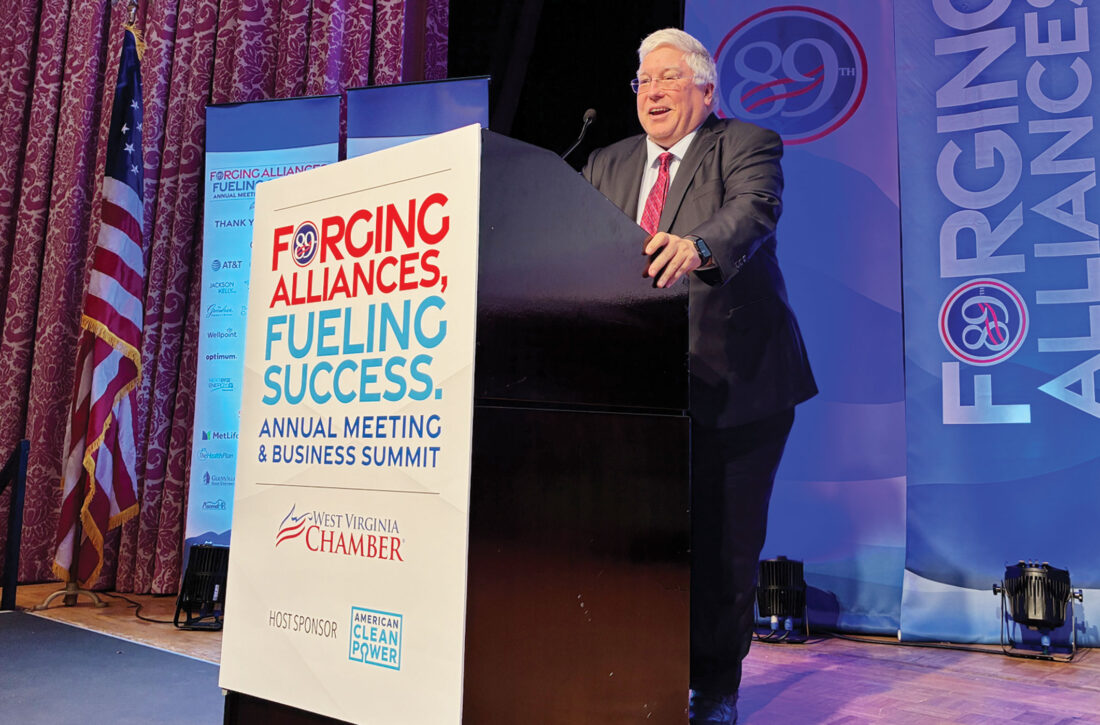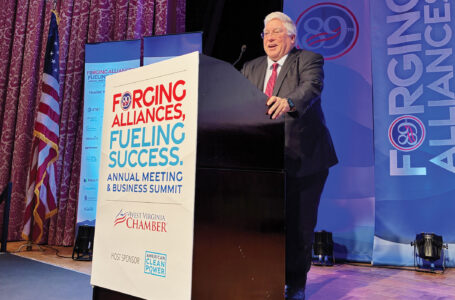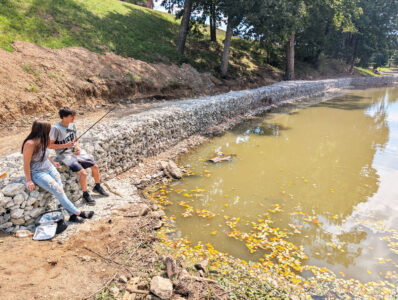Gov. Morrisey lays out vision for economic growth to business leaders

Gov. Patrick Morrisey briefed attendees of the West Virginia Chamber of Commerce on his plans to improve investment in economic development, energy, and jobs. (Photo by Steven Allen Adams)
WHITE SULPHUR SPRINGS — Improving how West Virginia invests in potential new businesses, making the state the battery of the east coast, and reversing the trend in labor force participation were all part of plans laid out Thursday by Gov. Patrick Morrisey at the state’s premier business event.
Morrisey spoke Thursday morning on the second day at the West Virginia Chamber of Commerce 89th Annual Meeting and Business Summit at the Greenbrier Resort.
“I love seeing the great crowd here; businesses from all across West Virginia, and people coming here to celebrate the opportunity that we have right here in West Virginia, which I think is unmatched anywhere across America,” Morrisey said. “I’m happy to be here because we have a chance to have a conversation and to talk about some of the transformational projects that are underway, what’s going on in West Virginia, as well as a lot of the work that we are undertaking.”
Morrisey laid out an ambitious plan for economic growth and transformation, with a strategy focused on leveraging the state’s abundant energy resources — particularly coal, natural gas, and nuclear power — to become a national energy powerhouse and a hub for the data economy. Part of this plan revolves around a new 50 by 50 initiative, aimed at increasing base load electric generating capacity in state from 16 gigawatts to 50 gigawatts by 2050.
“I can promise you that this policy is designed to be ambitious, and it’s going to fuel the next phase of power generation in our country,” Morrisey said. “It’s pushing to increase reliability by prioritizing stable sources of fuel, primarily coal, natural gas, and nuclear. By maintaining the building out of our grid – our 50 by 50 initiative – that’s going to make West Virginia by far the leading per capita exporter of energy in the nation.”
Bills introduced earlier this year on behalf of Morrisey and signed into law are part of his plan to cut red tape and speed up the building process, such as legislation creating a one-stop permitting dashboard for faster turnaround on permit approvals; and a new law to allow occupational licensing reciprocity to give qualified workers incentives to move to West Virginia and quickly begin construction projects.
“Already, in just a few months since that bill’s passed, we’ve seen things that are moving the needle,” Morrisey said. “We’re increasing the number of contractors registered in the state. Since this time last year, if you look at the April through June timeline, things are getting better. We’ve seen an 8% increase year-over-year. I think that’s just beginning. We’re going to see a lot more movement in that area.”
Morrisey said these efforts will help with another bill passed by the Legislature earlier this year to incentivize the construction and location in West Virginia of data centers powered by their own microgrids.
“West Virginia should be out in front taking the lead. Our data center bill is designed to make that happen,” Morrisey said. “Virtually everything you need online. it’s going to require extensive cloud infrastructure and computing power. So, the need for processing and more servers is only going to grow. This is going to require a massive buildout in our nation’s power grid, which West Virginia has built the ample resources and development ready, and the space to accommodate.”
Property tax revenue generated by new data centers and microgrid projects will be divided between host counties, other counties, a grid resiliency fund, economic development, and a fund to offset future personal income tax cuts.
“The bill that we passed for data centers, that didn’t change or increase taxes in any way,” Morrisey said. “But it did modify the distribution of the resources in order to reward companies that invest in West Virginia and our power grid, and create a dedicated stream of new income for future economic projects.”
Morrisey also acknowledged West Virginia’s low labor force participation rate, which remains one of the worst in the nation. The Morrisey administration is working on plans to recruit, retain, and retrain workers, revamp the website and services offered by WorkForce West Virginia, and collaborate with the business community to determine workforce needs.
“Let’s face it, we have to lift up our workforce participation rate. I would argue that’s the number one thing we have to do in the State of West Virginia,” Morrisey said.
Under previous administrations, deals were made through state economic development agencies to provide grants or loans to companies to lure them to West Virginia. While some companies, such as Nucor Steel and Form Energy have made good on their promises to build in West Virginia, other projects have fallen through the cracks.
Morrisey wants to invest in new businesses as well, but his Department of Commerce and economic development officials want to take a more cautious approach, evaluating potential investments based on return on investment (ROI).
“We have a strategy. That’s a strategy to direct all of the state’s resources and approaches, always thinking about economic development projects and initiatives that allow us to do more with less and ensure that our taxpayers are getting the best ROI to their hard-earned dollars,” Morrisey said. “We have to enhance West Virginia’s investment plans by lowering the regulatory and the capital barriers…We have to closely scrutinize the ROI of every taxpayer dollar from an economic development-respect.”



